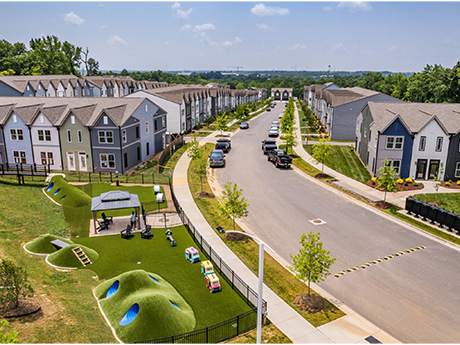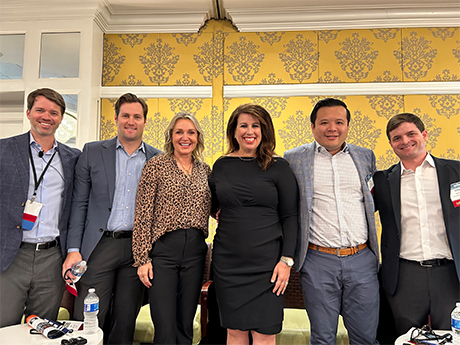CHARLOTTE, N.C. — Build-to-rent (BTR), or purpose-built neighborhoods of single-family rental homes, has been an emerging subsector of the multifamily continuum the past several years. The housing type fills a niche for renters as it offers more living space and privacy than typical apartments, but is more affordable and amenitized than for-sale homes.
The BTR sector began its ascent during the early years of the COVID-19 pandemic when a confluence of factors —the rise in work-from-home and hybrid work schedules, an increase in household formation of younger millennials, the desirability of more private space including garages and backyards — led to a sharp increase in demand for single-family rental (SFR) homes.
Underpinning the increased demand for BTR living is the unaffordability of homeownership for a large swath of Americans. As of mid-year, home prices are now 47 percent higher than they were in early 2020, according to Harvard’s Joint Center for Housing Studies. Home insurance premiums have also risen aggressively in the recent past — up 21 percent between 2022 and 2023, according to the study. Meanwhile, mortgage payments are increasingly untenable as interest rates have also risen dramatically in recent years.
For these reasons, institutional investors are actively participating in BTR’s growth story. Perhaps the most notable example is Blackstone acquiring Tricon Residential in a $3.5 billion deal that takes the Toronto-based company private. On top of the baseline acquisition, which was announced in January, Blackstone stated it would invest $1 billion to continue Tricon’s development pipeline of BTR homes.
Tricon’s first BTR project delivered since the acquisition was a 161-unit community in the Sacramento suburb of Lincoln, Calif., called Tricon Twelve Bridges. The property, which was developed in partnership with Sares Regis, features both single-family homes and townhomes, as well as a swimming pool, clubhouse and community spaces.
In addition to the Blackstone-Tricon news, Pretium Partners is raising $1 billion in a new fund to acquire BTR homes, and Charlotte-based Crescent Communities announced that it is raising $235 million with Heitman to develop BTR properties in 14 markets. The new communities will operate under the Harmon by Crescent Communities brand.
“We’re going to do four deals with them in Dallas, Phoenix, Greensboro [North Carolina] and Nashville, and then it gives us some room to potentially do one and two more with the idea of being a long-term hold,” said Tony Chen, senior managing director of Crescent Communities. “Building a [BTR] portfolio of scale has always been our goal within this platform.”
Chen added that BTR is in its infancy in terms of being an institutional property sector.
“BTR is still an evolving process,” he said. “And it will continue to be as more capital comes into the space.”
Chen’s comments came during the BTR/SFR panel at InterFace Multifamily Carolinas, an annual conference held on May 22 at the Hilton Charlotte Uptown hotel. Hosted by InterFace Conference Group and Southeast Real Estate Business, the event drew 272 attendees. John Currin, senior vice president of investment sales at Northmarq, moderated the panel.
Growing in sophistication
While still in early innings, the BTR space is evolving in interesting ways, according to the panelists. Chen said that the previous stages of the sector were oversimplified from a product delivery and operations standpoint.
“From 2018 to 2021, everyone just said, ‘The amenity is a house with a backyard,’” said Chen. “That’s just not what we believe anymore.”

The panel included executives from several companies that own and/or operate both multifamily and BTR, including Greystar and RangeWater Real Estate. Lisa Taylor, senior managing director of SFR and BTR at Greystar, said that one of the touches that may go under the radar for new BTR projects is parking.
“People have cars, so a one-car garage for a three- or four-bedroom home in a community with limited pad parking or no street parking is going to be challenging,” said Taylor.
Even more fundamental is location, according to Marcie Williams, CEO of RKW Residential, which manages both traditional multifamily communities and BTR projects. She noted that the blocking and tackling of operations is a close second in terms of priority for potential renters, with an emphasis on optionality, on-demand customer service and frictionless experiences.
“I feel bullish on the future of the BTR sector, as long as we can continue to provide the value that renters are looking for,” said Williams. “Our BTR rents are almost 20 percent higher than our multifamily rents. And everybody still wants service, but it’s how we deliver the service, whether it’s technology or personal touch. We want to make sure that we are giving them what they want, when they want.”
Overall the BTR sector shares more traits with the traditional multifamily sector than previously expected. Timothy Graul, vice president of acquisitions and investments at Bluerock, said that multifamily stakeholders make for better dance partners for BTR investments and developments than traditional single-family homebuilders.
“We are doing better partnering with multifamily developers that are switching into BTR; they just have a better sense generally for what the customer needs and the ability to get the deal done,” said Graul.
He added that multifamily developers have more experience on the nuances of today’s capital markets environment versus traditional single-family homebuilders, thus companies such as Bluerock have a shorthand with multifamily players when it comes to financing BTR developments.
“Capital wants to be in BTR, and it’s a lot more familiar to invest with somebody who has done it on the multifamily side,” said Graul.
Chen added that, while there is some natural cross pollination between the traditional multifamily sector and BTR, there are some fundamental differences that are important to remember, namely the physical aspects of BTR communities.
“[Crescent Communities] is only building, for the most part, three- and four-bedroom homes with attached garages, so we do think it’s a different product and different customer demographic than multifamily, which is how we’re protecting our risk,” said Chen.
Breaking new ground
Currin of Northmarq mentioned in one of his questions to the panel that a recent survey of BTR renters revealed that the demographics of the BTR cohort falls relatively evenly among four categories: young couples and empty nesters; young families with kids; mature families with kids; and mature couples without kids.
Understanding the “four legs of the barstool” of the BTR cohort is coming at an ideal time as development is kicking into high gear for the BTR sector. Nationally, there are nearly 120,000 BTR units under construction as of May 2024, according to data from RealPage Market Analytics. As far as hotspot regions, developers in the South and West lead the pack, claiming roughly 88 percent of the pipeline combined.
On its own, the South region, which includes Texas, claims 64 percent of the nation’s BTR units under construction. The South’s pipeline totals 76,674 BTR units scheduled for completion through second-quarter 2027, including properties in lease-up while construction is ongoing. The West region has a total 28,618 BTR units under construction that are scheduled for completion through third-quarter 2026.
Hines is underway on the next phase of a $200 million BTR project in the Charlotte suburb of Pineville, N.C. A fund sponsored by the Houston-based investor and developer recently acquired the community, called Blu South, that features 341 recently delivered homes with 210 more under construction. Hines estimates that Blu South will be fully delivered by third-quarter 2025.
Chase Davidson, manager of BTR and capital markets at RangeWater, said that the Atlanta-based firm is focused on providing a wider array of unit types at its BTR projects going forward.
“At one of our projects in Atlanta, it has 56 single-family detached homes and 100 townhomes,” said Davidson. “Providing a lower price point with entry homes all the way up to something that works for a big family in the same community has provided outperformance in absorption.”
Graul added that understanding the housing stock in a given market is crucial in terms of adding new BTR supply.
“You can’t put stacked townhomes 30 miles outside the city,” said Graul. “If all the houses in a three-square-mile radius are single-family detached, you probably need to have some form of single-family detached.”
The panelists agreed that as far as demand for BTR living moving forward, the sector remains in a goldilocks position of offering flexibility, amenities and affordability relative to their traditional multifamily and single-family counterparts.
“The diversity in the tenant base shows that people want to live at these properties, and that will probably not change,” said Graul.
Taylor added that since BTR is a relative newcomer to the multifamily industry, education remains a chief obstacle to getting deals off the ground, both for the general public and to prospective renters.
“One of the biggest challenges is educating the general public and prospective residents that that a certain project is a for-rent development,” said Taylor. “Signage is very important, so we make sure the homebuilder doesn’t have restrictions on [signage] in place when we buy phase IV or V of a project.”
— John Nelson


